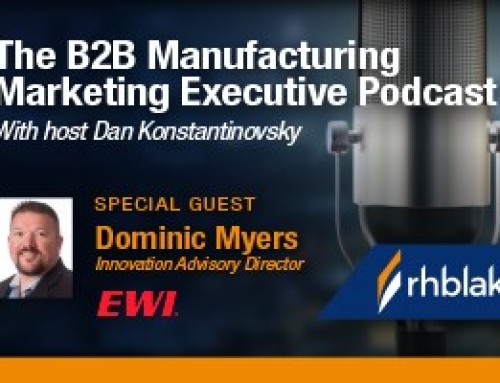Interview with Mathias Bohge
Welcome to the B2B Manufacturing Marketing Executive Podcast.
If you want to learn how leading B2B Marketers are achieving excellent growth results, you are in the right place. This episode is brought to you by R. H. Blake a leading B2B and manufacturing focused marketing agency. To learn more, visit rhblake.com. Now here is your host Dan Konstantinovsky.
Interview with Mathias Bohge
Welcome to the B2B Manufacturing Marketing Executive Podcast.
If you want to learn how leading B2B Marketers are achieving excellent growth results, you are in the right place. This episode is brought to you by R. H. Blake a leading B2B and manufacturing focused marketing agency. To learn more, visit rhblake.com. Now here is your host Dan Konstantinovsky.

So Mathias, thank you so much and welcome to the podcast, welcome. Thanks for having me. So maybe just at a high level, you know, maybe some of our listeners today aren’t familiar what is an industrial wireless network? And how does it work in general?
It’s a network as you know it from home, for example. Um, the specialty about industrial networks is that for industrial networks you mostly differentiate between IT networks and OT networks where it is more or less the same that you do have today or to at home or in the office, namely having computers talk to each other, printing jobs and everything like organizational stuff. And then in industry you have these so-called operational technology networks. So OT and in OT networks it’s a lot about deterministic and reliability behavior. that means if you want to control machinery, if you want to control robots, if you want to make sure that the jobs on the shop floor are done as you need them to be done, you need very, very reliable connections.
So you have certain special industrial protocols that account for these tasks that you can use and, and well, some famous one are Ethernet IP, for example. Prof. Inet, these kind of kind of protocols that you use. And typically this is what you would refer to as an industrial network. There’s also a version that’s called industrial Ethernet and again, Prof Inet, Ethernet, IP and so on. They are part of this family of protocols.
Excellent. And maybe typically, what types of issues or problems does this technology solve? For a manufacturer.
Well, in general, when turning to the modern factory, you have a completely interconnected factory, right. We have the different industrial revolutions starting from, you know, the engine, the steam engine and then the electronics, computer technology and so on.
These days it’s all about connected production. So you want the machinery to be able to talk to each other, to, you know, discuss certain jobs.
You want to be of control of the several processes that are going on, you want to be able to see failures very easily. So it’s yeah, modern production really relies on information. And I think this is not a surprise.
This is what you see everywhere in the world, not only in industrial settings. So, um, yeah, the more data you have, the more you collect, the more intelligent you are, the smarter you can work.
And with this you can, yeah, have different settings within your facility, of course, which you can control via computer technology. And you need these kind of networks in order for everything to work together, right?
To have the different machines, computers. Yeah. Exchange and having the necessary data at hand when they needed it. You know, you mentioned reliability there. What does good look like? You know, when it comes to this technology from a reliability perspective, You know, because many of our listeners are in the manufacturing space and unplanned downtime, as you can imagine, is the worst thing, one of the worst things that could happen.
So could you talk a little bit about reliability and how this technology kind of, you know, helps support that?
Yeah. So in general, reliability is referred to of course that you have a stable communication network. That means no downtime if not planned. Of course. No, never say never. This is not really the truth.
This is not what can happen. But if you look at Wi-Fi networks, for example, you typically lose 1 out of 100 or 1 out of 1000 packets. That’s a pretty regular packet loss that you find in these kinds of networks.
And this is what you can do if you are trying to control machinery over such networks, right? So you usually want to get to a failure. Resistance to 99.9999999999. Hope I counted the lines correctly. where we want to go is into the direction of losing 1 out of a million, 1 out of 10 million or 1 of 100 million packets, something like that. Yeah. And this is something with cable, which is not a problem to achieve.
Modern technology can achieve that easily. For wireless, it’s a different game. And the major reason for that is that the wireless channel itself is non-deterministic, shows a non-deterministic behavior.
It’s a function of place. You are the time and the frequency you operate in. And each point where you could be located at each point in time you have a different attenuation of the channel.
So it’s a clearly non-deterministic channel, the wireless channel compared to a cable. Cable usually you set it up once you keep it as is. And if the temperature doesn’t change dramatically or somebody comes and cuts the cable, it’s just the same channel characteristics for all the time. This is not true for wireless. So what we do with our technology is we bring technology in that helps you to have a reliable network based on a non-deterministic channel. Yeah. So we have certain features. For example, the concept of massive cooperation among nodes that make sure that even if your channel breaks down or you have the so-called fading holes and attenuation, a very, very high attenuation at a certain point in time that you can take a reroute in order to deliver your data anyways. Yeah. So this is what we refer to as reliable behavior that you can be sure that the packets that you send arrive within a certain span, time span, the very, very high reliability.
Let’s say one to the power of minus seven, ten to the power of minus seven. Well. Oh, I’m sorry. No, please, Dan. Just a quick question. Just to ensure that reliability, what are some of the benefits or key considerations that people need to consider when deploying these kind of networks in an industrial setting?
So of course, what you need to or what you want to do usually in these kind of networks is you want to have some control looping of machinery or you have some safety functionality that needs to be realized.
So what you have on top of the regular industrial protocols is mostly a safety protocol running. And what this safety protocol does is it just checks whether the link is up. Is the link up? is the link up?
So a lot of packets are sent just to check whether the link is up and whether they get an acknowledgement in order to see that the link actually is up. And what these protocols do is if they don’t get the acknowledgment, they will send the system in a fail-safe situation or in a fail-safe status. So a robot would just, you know, stand still, for example. And in order to still operate a network using a safety protocol, you need a very reliable wireless network. Yeah, if you want to use wireless. So if you use standard wifi, the system will go into a failsafe all the time.
So and this is where we get in. So if you have a connection for control or safety functionality where you have a certain cyclic time, where you need data must arrive. Otherwise process gets broken or fail-safe mode will kick in. This is where you need ultra-reliable low latency communications technology.
So this is a kind of family of wireless communication networks where we belong to. Does that answer your question? Yes. So maybe building on top of that. Who do you feel is best suited to leverage this type of technology? So maybe from an application perspective or a use case, talk a little bit about some of the maybe successes you’ve had and kind of the profile of these customers.
So I guess the easiest use case you can think of is the emergency stop button. Yeah. So if you have emergency stop button by, I don’t know whether it’s by law, but at least by, what’s the name in English? By certification. You have to make sure that actually this emergency stop button works once it’s there. Right? Right.
So if you have a wireless device with an emergency stop button, that means that it’s controlling all the time, whether the link is up, and whether if the link is down, it will put the system again in a fail-safe mode. So having a wireless HMI, for example, human machine interface with an emergency stop button requires the safety functionality and also then requires communication technology as we have it.
That’s why it still these days, most, if not all, the industrial robots still have a teaching panel with cable. And this is one of the projects we have with a German robot manufacturer where we provide technology in order to have wireless teaching panels, including emergency and control functionality. This is one of the use cases. Another use case is, for example, in pair rides. Okay, or amusement rides, park rides where you have a lot of turning systems where a lot of motion is going on and where you still want to control the shuttles or whatever is going there. Via safety communication. So this is one of the other use cases that we are. And then in production and automotive, for example, if you’re turning away from belts or turning away from the monorail systems where you just would have HGVs or skids that are pushed through a line, with the cars being constructed on top of this agv or skid, you cannot put them on a cable because then they’re not free to move anymore. So you have to have them connected wirelessly. And if then you have some moving as for example, a scissors table, you know, just to have the car which is constructed in the height of the worker behind it. Then you need some kind of safety communication and then again you need wireless that’s reliable enough to support the safety functionality that you need. So these are use cases which we do with global players in these areas. And yeah, it’s getting more and more, which we like a lot. And yeah, I think the more flexible production is getting, the more smart production is getting, the more this kind of technology is needed and requested.
Excellent. And so maybe, what are some KPIs or ROI considerations that these, you know, that these customers are looking for, You know, in those initial conversations?
Well, in general, KPIs, of course, the latency requirements. So the question is what’s the what’s the minimum guaranteed latency you can achieve? It’s mostly in the 1 or 2 digit millisecond area which need to be supported. Then the distance is always a question. So how far can you get with your wireless solution until you need, for example a handover or some other mechanisms? Another question, of course, is the energy and energy consumption at this part data throughput, while I have to say that data throughput at the moment is not that much of importance because control and also safety traffic, they don’t require this big data set data packet sizes. Yeah, but these are typical KPIs that that you, that you see that you read when you’re working on this kind of use cases scenarios.
Excellent. Well, Mathias, this has been extremely interesting. You know, for many listeners, this could be the first time that they’re learning about this technology and definitely the use cases. So really appreciate you spending some time with us, educating us on the technology, the space and the potential problems that it could solve.
So just wanted to thank you again. If a listener wants to learn more, where’s a good place to reach you or website?
Yeah. Our website is R3 dot group. Yep. R3 dot group. Of course, you also find myself on LinkedIn. That’s always a good first point of contact. And I guess you will also happily forward everybody who requests.
Absolutely.
We do have several publications out there also. So if you look the web for echo ring, you will also find a lot of literature on that. And so the general term about this kind of technology is URLLC: ultra reliable low latency communications. So these are the keywords I guess, that you need to remember. Echo Ring is easier, so look for that and everything else will come to your mind afterwards.
Yes.
Excellent. Well, thank you so much again for your time. Really appreciate it.
Thank you, Mathias. My pleasure.









